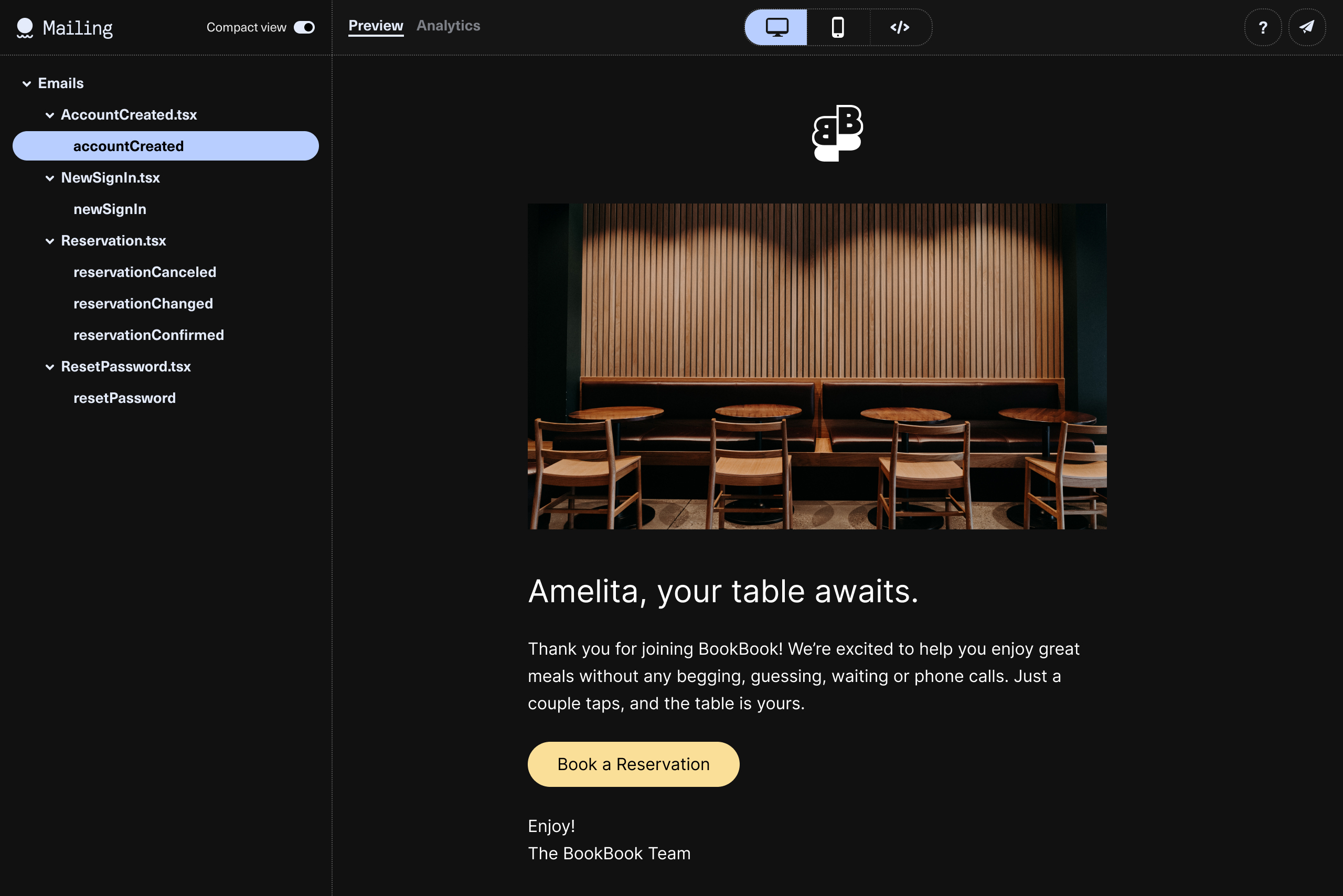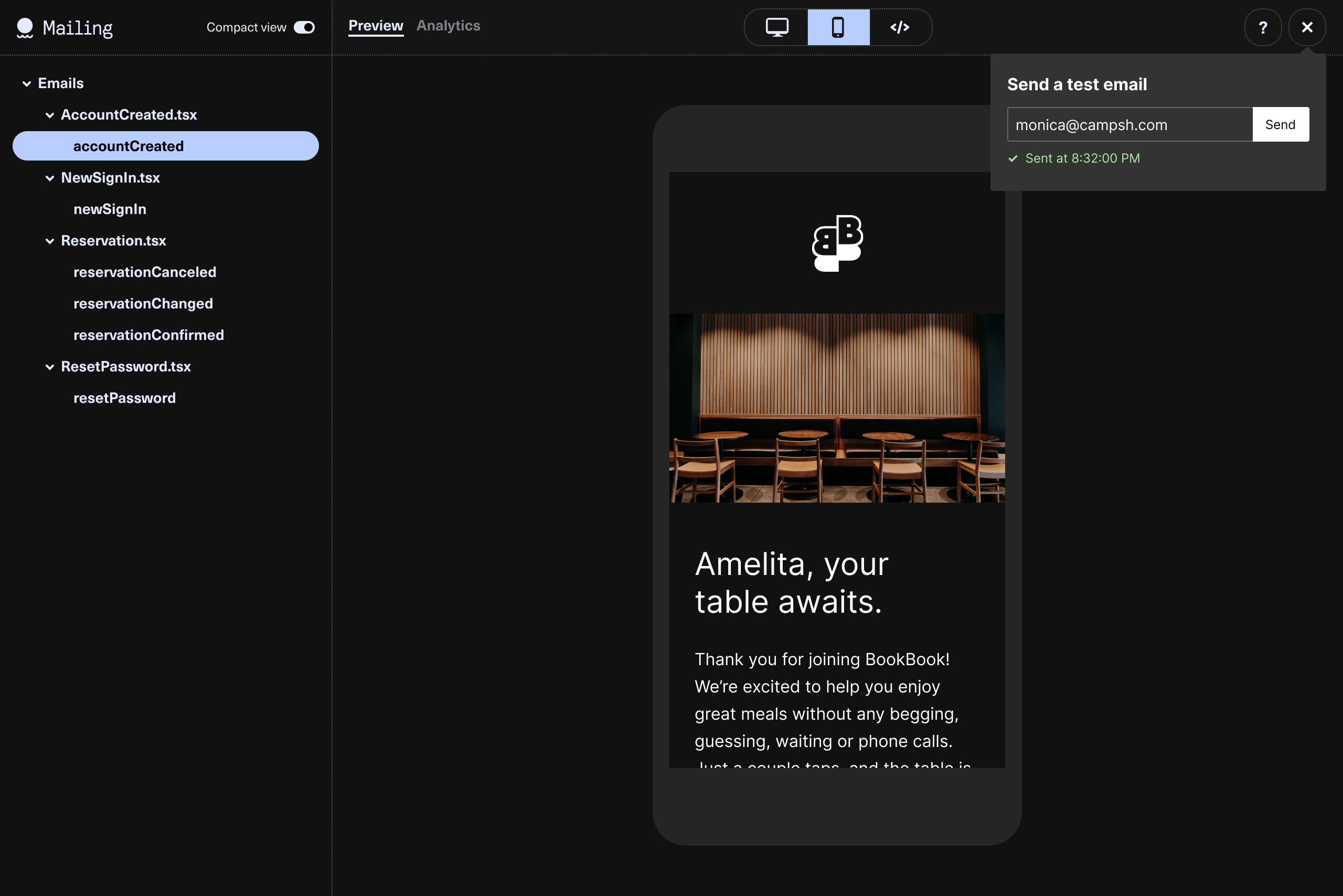




● Build, test, send emails with React
- Email templates with React components
- MJML components that work across clients (Outlook!)
- Preview server with live reload for quick development
- Dev mode opens emails in your browser instead of sending
- Test mode for ensuring emails send and have the correct content
- Plays well with js frameworks like next.js, redwood.js, remix
- Written in TypeScript, inspired by Action Mailer from Ruby on Rails
● Why?
We’re longtime users of Action Mailer and wanted something similar for our typescript/react apps. We didn’t find anything, so we decided to build Mailing. We added some features that we would’ve liked in Action Mailer, like a mobile toggle (with hotkeys), and the ability to send a test email from the browser while developing. We went all in on MJML so that we (almost) never have to think about email clients or nested tables :)
● Demo

● Setup
- Install mailing with yarn or npm:
yarn:
yarn add mailing mailing-core next
npm:
npm install --save mailing mailing-core next
Note: you may want to add mailing as a dev dependency instead if you don't plan to use the preview function outside of development. mailing-core exports buildSendMail, which returns the sendMail function
Note: mailing requires version 17 or 18 of react and react-dom, so if you're not already in a react-based app, you'll need to add the following:
yarn:
yarn add react react-dom
npm:
npm install --save react react-dom
- Run
npx mailing to start the preview server and scaffold your emails directory. This will create the following directory for all of your emails:
emails
├── AccountCreated.tsx
├── NewSignIn.tsx
├── Reservation.tsx
├── ResetPassword.tsx
├── components // shared components go in here
│ ├── BulletedList.tsx
│ ├── ButtonPrimary.tsx
│ ├── Footer.tsx
│ ├── Head.tsx
│ ├── Header.tsx
│ └── theme.ts
├── index.ts // this exports sendMail and is where your SMTP config goes
└── previews // use previews to develop and check templates
├── AccountCreated.tsx
├── NewSignIn.tsx
├── Reservation.tsx
└── ResetPassword.tsx
- Configure your email transport and
defaultFrom in emails/index.ts. It defaults to nodemailer's SMTP transport, but you can read about others here.
Example SendGrid transport:
const transport = nodemailer.createTransport({
host: "smtp.sendgrid.net",
port: 587,
auth: {
user: "apikey",
pass: process.env.SEND_GRID_KEY,
},
});
- Finally, send your first email like so:
import { sendMail } from "emails";
import AccountCreated from "emails/AccountCreated";
sendMail({
subject: "My First Email",
to: "tester@example.com",
cc: "tester+cc@example.com",
bcc: ["tester+bcc@example.com", "tester+bcc2@example.com"],
component: <AccountCreated firstName="Amelita" />,
});
● Developing with email previews
Mailing includes a development mode for working on your emails. Running npx mailing in dev will boot the preview server on localhost:3883 and show you all previews in emails/previews. The previews live reload when files in the emails directory change. Previews are just functions that return one of your emails loaded up with props. We recommend grouping all previews for the same email template in a file at emails/previews/TemplateName.tsx.
For example, here's emails/previews/AccountCreated.tsx:
import AccountCreated from "../AccountCreated";
export function accountCreated() {
return <AccountCreated name="Amelita" />;
}
On the left, you'll see a list of all of your emails. On the right, you'll see an individual email preview with a mobile/desktop/HTML toggle and live reload as you edit:

When your email is nice, send it to yourself or your QA tool of choice for final testing (we like Litmus):

● Templates
We ship with a few templates to help you get started. These get added to your emails directory upon initialization with npx mailing init. We recommend using these as starting points and modifying them to fit your use case. Check them out here.
● Testing emails with jest
When NODE_ENV === "test", calling sendMail pushes messages into a queue for later examination. The mail-core package exports a couple of functions for testing that emails send with the correct content.
function getTestMailQueue(): Promise<Mail[]>
Retrieve the test message queue.
function clearTestMailQueue(): Promise<void>
Clear the test message queue. You probably want to call this before tests that use the queue.
Example:
import { sendMail } from "emails";
import { getTestMailQueue, clearTestMailQueue } from "mailing/core";
import IssueNotification from "emails/IssueNotification";
describe("Example API", () => {
it("sends an email when an issue is ready for review", () => {
await clearTestEmailQueue();
const emails = await getTestMailQueue();
expect(emails.length).toBe(1);
expect(emails[0].subject).toMatch("Re: An issue title");
expect(emails[0].html).toMatch("READY FOR REVIEW");
expect(emails[0].html).toMatch("ready for QA");
});
});
● CLI
npx mailing init initializes a project then starts the development server
npx mailing preview launches the development server
npx mailing server build builds the next app in .mailing
npx mailing server start starts the next app built in .mailing/.next
npx mailing server builds and starts it
npx mailing export-previews exports template previews as plain html files
npx mailing runs init then preview
npx mm is a cute alias for npx mailing
source entrypoint
mailing.config.js
Running npx mailing init generates a mailing.config.js file that will be used as default options for the CLI commands. The default options are:
{
"typescript": ???, // ("true" if you have a tsconfig.json in your root, otherwise "false")
"emailsDir": "./emails",
"outDir": "./previews_html" // (directory for export-previews html output)
}
Append --help to your CLI command for a full list of supported options. Any of these options can be added to your config file.
● REST API
With the REST API, you can use mailing for email templating even if most of your app is not written in TypeScript or JavaScript.
GET /api/render takes a template name and props and returns your rendered HTML ready to be sent. Example
GET /api/previews returns the list of previews. Example
GET /api/previews/[previewClass]/[previewFunction] returns the rendered preview and data for /previews/[previewClass]/[previewFunction]. Example
● Deployment
The mailing preview server has a super power: it’s easy to deploy a fast production version when you want to share templates with your team or clients. You can also hit the REST API on your deployed mailing server to generate HTML from your templates.
Learn more and get started here.
● Telemetry
To help understand how people are using mailing so that we can prioritize efforts, mailing collects some anonymized telemetry about usage.
● Contributing
Want to improve Mailing? Incredible. Try it out, file an issue or open a PR!
Check the CONTRIBUTING.md for more info.









